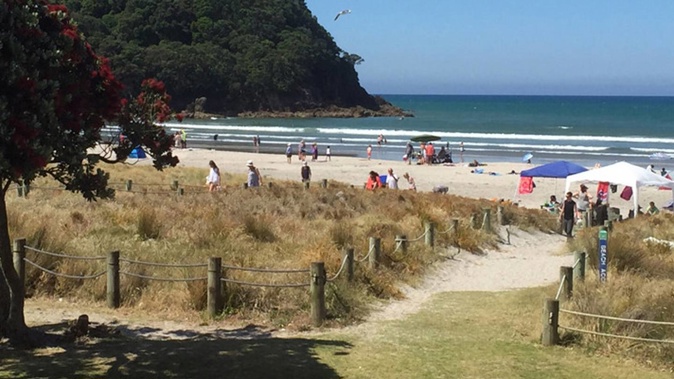
A woman has died after an incident at Waihī Beach, with initial indications suggesting she has been attacked by a shark.
Emergency services were called to the scene about 5.10pm after reports of a woman being injured in the water, police said in a statement.
The woman died at the scene a short time later and the incident will be referred to the Coroner.
Shark scientist Riley Elliott says it's hard to speculate what species of shark attacked the woman without all the facts.
However, there has been evidence of juvenile and immature Great Whites in the area as of last summer.
Bronze Whalers are more common in the area but haven't had an adverse interaction with a human in a very long time, Elliott says.
"It's very uncommon to have shark attacks in New Zealand in the world in general, especially fatal ones," he said.
"Shark attacks are incredibly rare and if you see one, remain calm, alert people around you, and calmly vacate the water."
Elliott says his thoughts are with the family of the woman who died in the "tragic" incident.
/cloudfront-ap-southeast-2.images.arcpublishing.com/nzme/LPMGKIFZOW4TU7LDQ4LH4G7DNE.jpg?width=618&height=412&mode=max)
Shark scientist Riley Elliott says it's hard to speculate what species of shark attacked the woman. Photo / Supplied
Shark attacks around the world are fairly uncommon given the number of people who swim in their domain, rarer still fatal attacks, Elliot said.
St John sent two ambulances, a first response unit, and a helicopter to Waihī Beach initially, a spokeswoman told the Herald.
Allan Mundy, national search and rescue manager, Surf Lifesaving New Zealand told NZME: "We know that these animals are ever present in our environment. What we ask people to do is always be vigilant, respect the animals, it's their home not ours."
He also said people should consider what they are doing on the beach.
"We really encourage people to do things like not gutting fish on the beach, that's going to attract all sorts of animals, crabs as well as stingrays and sharks. Fisherman, if they're are fishing on the beach, we ask, if they are going to gut the animal, do it at home.
"In the past, divers have become hassled by sharks because they've got the fish that they've speared on their dive belt. So, think about what the animals are attracted to, and minimise that yourself."
Mundy wasn't able to elaborate on where on Wahi Beach the attack occurred, as it was now a police matter.
Mundy said Surf Lifesaving doesn't have the power to close the beach and that decision is made by either the regional or city council.
"It comes down to where the attack actually happened. The circumstances of the attack, which are still very sketchy at this point in time ... it will come down to the regional council.
"They will have a lot of information at their disposal prior to making that decision."
In December, Clinton Duffy from the Department of Conservation said according to satellite imagery the sea surface temperatures off northern New Zealand was warmer this summer as a result of La Nina weather phenomenon.
"However, it is common for sharks, particularly adult females, to move into productive shallow coastal waters at this time of the year anyway."
He said this was a result of the shallows receiving more light and warming quicker and in spring biological production kicks off earlier than it does in deep offshore waters.
"Several species of sharks move inshore to give birth in these shallow productive areas so their pups have the best chance of survival. Other species move inshore at the same time to feed on abundant fishes.
"This is an annual phenomenon. The timing of the inshore-offshore movements of sharks is probably influenced by both temperature and light levels.
"It should also be remembered that there is always likely to be some sharks inshore regardless of the time of year."
In July 2019, a 2m-long shark washed up dead at Waihī Beach.
And 13 months ago a massive great white shark was spotted by people on a boat near Waihī Beach.
It was estimated the shark was about 3.5m long.
Waihī Beach was also closed down in January 2014 after a shark was a small shark was spotted near the shoreline.
The beach was closed after lifeguards and swimmers spotted the shark.
In February, 2013, father-of-one Adam Strange was killed after he was attacked by a shark off Muriwai Beach.
The 46-year-old had been out swimming when he was attacked.
A policeman later fired up to 12 shots at the killer shark as bids were made to retrieve Strange's body.
The police Eagle helicopter spotted the shark while it was still attacking Strange and stayed above until officers got to the beach.
One was sent out on the water in an inflatable rescue boat with three lifeguards.
It is understood that when the inflatable got to Strange, the shark still had him in its grip. He was already dead. The officer used a M4 Bushmaster rifle to shoot at the shark to get it to release the body.
Witness Pio Mose told the Herald at the time that was fishing with a group of men on the rocks when he saw the "huge" shark attack Strange just 50m away. "All of a sudden there was blood everywhere."
Mose said he saw Strange struggle with the shark before it swam away. He was keeping his head above the water before the shark returned.
"I yelled at him to swim to the rocks."Mose watched helplessly as the shark took Strange's body out to sea, and when lifeguards arrived, he directed them to the group of sharks.
"It's awful - it's scary like a nightmare to me. All I was thinking was I wanted to jump in the water and help but I didn't want to get attacked by a shark too."
A resident who lives above Māori Bay saw the drama unfolding.
"Then I saw the IRB on the water and heard the explosions and saw water flying up. They were shooting at the shark in an effort to get it to release the body.
"There would have been up to 10 to a dozen shots fired - some in very quick succession."
Up to 2014, there had been 12 reported fatal shark attacks in New Zealand.
That includes one in 1966 in Auckland's Manukau Harbour, plus at Te Kaha (1976), Napier (1896), Oakura (1966), Wellington (1852), Kumara (1896), Moeraki (1907 and 1967), St Clair (1964 and 1967) and Aramoana (1968).
The 1964 fatal attack at St Clair, Dunedin, took the life of 19-year-old lifeguard Leslie Jordan. Two former St Clair lifeguards reached Jordan, bringing him back to the beach on their surfboards after a shark ripped off his right leg during a training swim. Jordan died from his injuries.
And tragedy struck the region of Taranaki in 1966 when 15-year-old New Plymouth schoolgirl Rae Marion Keightley was fatally mauled while bodysurfing off Oakura Beach.
Keightley had her left leg bitten from thigh to calf before surfboard rider Anthony Johns brought her to shore after the attack.
Last February a 60-year-old man had a lucky escape after while out surfing at Pauanui Beach, on the Coromandel.
The man was biten on the arm, before latching onto his surfboard.
"So I actually shouted at it 'f--- off!' and went to punch it in the eye and missed," he told the Herald' "Then I pulled my fist back and shouted 'f--- off!' again and got it right smack bang in the eye."
The shark finally disengaged after being punched twice.
Take your Radio, Podcasts and Music with you








